Science
(www.olympiadsuccess.com)
Chapter 9: Cell - Reproduction in Animals
Class: VIII
Exemplar Solutions
MULTIPLE CHOICE QUESTIONS
Question 1
Sets of reproductive terms are given below.
Choose the set that has an incorrect combination.
(a) sperm, testis, sperm duct, penis
(b) menstruation, egg, oviduct, uterus
(c) sperm, oviduct, egg, uterus
(d) ovulation, egg, oviduct, uterus
Answer 1 (c)
Question 2
In humans, the development of fertilised egg takes place in the
(a) ovary (c) oviduct
(b) testis (d) uterus
Answer 2 (d)
Question 3
In the list of animals given below, hen is the odd one out.
human being, cow, dog, hen
The reason for this is
(a) it undergoes internal fertilisation.
(b) it is oviparous.
(c) it is viviparous.
(d) it undergoes external fertilisation.
Answer 3 (b)
Question 4
Animals exhibiting external fertilisation produce a large number of gametes.
Pick the appropriate reason from the following.
(a) The animals are small in size and want to produce more offsprings.
(b) Food is available in plenty in water.
(c) To ensure better chance of fertilisation.
(d) Water promotes production of large number of gametes.
Answer 4 (c)
Question 5
Reproduction by budding takes place in
(a) hydra (c) paramecium
(b) amoeba (d) bacteria
Answer 5 (a)
Question 6
Which of the following statements about reproduction in humans is correct?
(a) Fertilisation takes place externally.
(b) Fertilisation takes place in the testes.
(c) During fertilisation egg moves towards the sperm.
(d) Fertilisation takes place in the human female.
Answer 6 (d)
Question 7
In human beings, after fertilisation, the structure which gets embedded in the wall of uterus is
(a) ovum (c) foetus
(b) embryo (d) zygote
Answer 7 (b)
Question 8
Aquatic animals in which fertilisation occurs in water are said to be:
(a) viviparous without fertilisation.
(b) oviparous with external fertilisation.
(c) viviparous with internal fertilisation.
(d) oviparous with internal fertilisation.
Answer 8 (b)
Question 9
After fertilisation, the resulting cell which gives rise to a new individual is the
(a) embryo (c) foetus
(b) ovum (d) zygote
Answer 9 (d)
Question 10
In human beings, the correct sequence of events during reproduction is
(a) gamete formation, fertilisation, zygote, embryo
(b) embryo, zygote, fertilisation, gamete formation
(c) fertilisation, gamete formation, embryo, zygote
(d) gamete formation, fertilisation, embryo, zygote
Answer 10 (a)
VERY SHORT ANSWER QUESTIONS
Question 11
Although 2 cells called gametes fuse, the product formed is a single cell called zygote. Justify.
Answer 11
During fertilisation, only the nucleus of the sperm moves into the egg cell and fuses with the egg nucleus to form the zygote. The sperm degenerates.
Question 12
Stages in the lifecycle of silkworm are given below. Write them in sequential order.
pupa, silkworm, egg, silkmoth
Answer 12
egg, caterpiller, pupa, silk moth
Question 13
What is the importance of reproduction?
Answer 13
It ensures the continuation of species generation after generation.
Question 14
In markets, eggs of birds are available but never eggs of dogs. Why?
Answer 14
Dogs do not lay eggs.
Question 15
The eggs of frogs do not have shells for protection, yet they are safe in water. How?
Answer 15
A layer of jelly covers the eggs of frog and provides protection.
SHORT ANSWER QUESTIONS
Question 16
Fill up the blanks with the terms given below:
body, asexual, binary, single, nucleus
Amoeba is a ___________ celled organism. It reproduces by ___________ reproduction. The process of reproduction begins by the division of its ___________ into two. This is followed by the division of its ___________ into two. This type of reproduction is called ___________ fission.
Answer 16
Single, asexual, nucleus, body, binary
Question 17
The term metamorphosis is not used while describing human development. Why?
Answer 17
In human beings, body parts of an adult are present from the time of birth itself. Whereas, in metamorphosis, the parts of the adult are different from those at the time of birth.
Question 18
Mother gives birth to a baby but the baby has characters of both parents. How is this possible?
Answer 18
Although mother gives birth to a child, fertilisation involves two gametes, one from the mother and the other from father. The zygote, therefore has both father and mother’s contribution. Since the zygote develops into the baby it has characters of both parents.
Question 19
How is reproduction in hydra different from that in amoeba?
Answer 19
Hydra reproduces by budding where an outgrowth arises from the parent and develops into a new individual. Amoeba reproduces by binary fission in which the division of nucleus is followed by division of the cell resulting in two individuals.
Question 20
State whether the following statements are True or False. If false, correct the statement:
(a) External fertilisation can occur both in water and on land.
(b) The eggs of fish are covered by hard shells for protection.
(c) Human egg has a head, middle piece and tail.
(d) In adult human females, a single mature egg is released into an oviduct every month.
Answer 20
(a) F; External fertilisation occurs only in water.
(b) F; The eggs of fish are covered by a jelly for protection.
(c) F; Human sperm has a head, middle piece and tail.
(d) T
Question 21
Why do only male gametes have a tail?
Answer 21
Because they have to be motile and reach the non-motile female gamete.
Question 22
What does Fig. 9.1 represent?
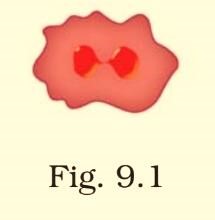
Answer 22
The figure shows an amoeba undergoing binary fissions with a dividing nucleus.
Question 23
Observe the figure given as Fig. 9.2 and answer the questions that follow.
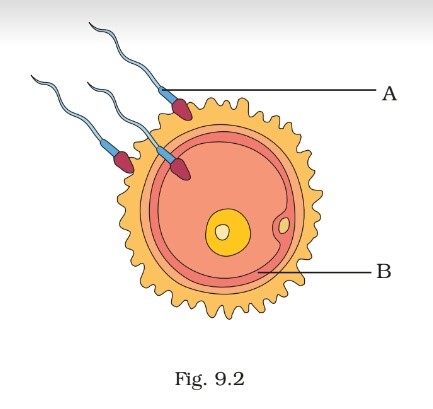
(a) Label A and B.
(b) Identify the process.
(c) What happens during this process and what is formed?
Answer 23
(a) A-sperm; B-ovum (egg)
(b) Fertilisation
(c) Sperm nucleus fuses with the egg nucleus to form the zygote.
LONG ANSWER QUESTIONS
Question 24
How can we say that fish exhibits external fertilisation?
Answer 24
Female fish release eggs into water and male fish releases sperms. Sperms swim randomly in water and comes in contact with the eggs. The nucleus of the sperm moves into the egg and fuses with it. Since fertilisation occurs in water, outside the female body, it is external fertilisation.
Question 25
After observing Fig. 9.3 answer the following.

Answer 25
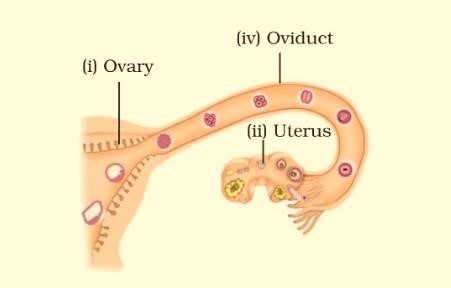
Question 26
Hens and frogs are both oviparous exhibiting different types of fertilisation. Explain.
Answer 26
Hens are oviparous in which internal fertilisation takes place. The fertilised egg develops into an embryo inside the body. However, the development of chick from the embryo takes place outside the body.
Frogs are oviparous in which both fertilisation and development of zygote to embryo and young ones occurs outside the body.
Question 27
Observe the following figures.
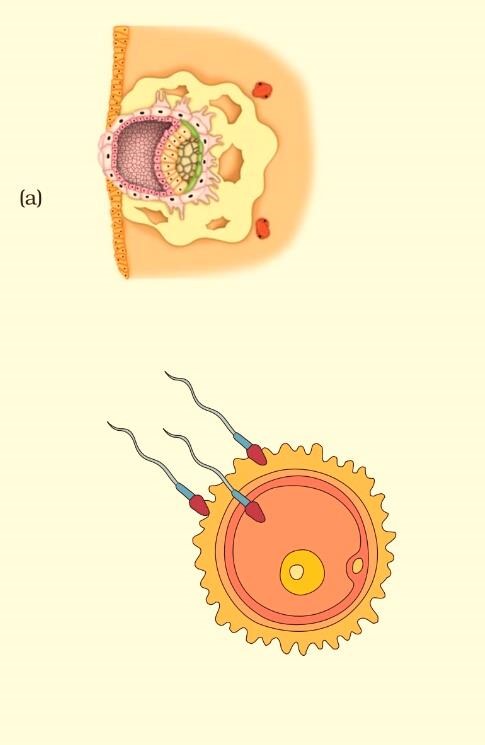
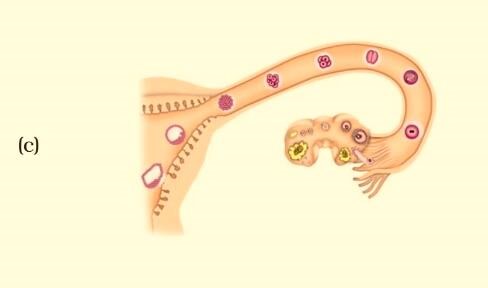
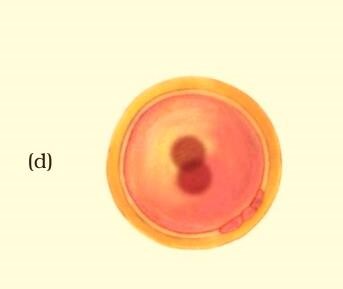
Answer 27
(i) (a) Embedding of the embryo in the uterus.
(b) Fertilisation.
(c) Zygote formation and development of an embryo from the zygote.
(d) Zygote showing fusion of nuclei.
(ii) The correct sequence is c, b, d, a
(iii) Zygote formation The sperm and the egg nuclei fuses to form a single nucleus resulting in the formation of a fertilised egg or zygote. (Note: One step is explained as an example. Students may explain any other step.)
Yearlong program for Olympiads preparation & to build necessary skills for future.
Explore More
Time to mark your calendar with the upcoming Olympiads exam schedule.
Explore More
Take your Olympiad preparation to next-level by taking LIVE Classes.
Explore More
Assess your performance by taking topic-wise and full length mock tests.
Explore More
Online tuitions for international compeitions like SASMO, SEAMO, etc for Grades 1-11.
Explore More